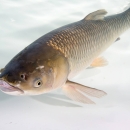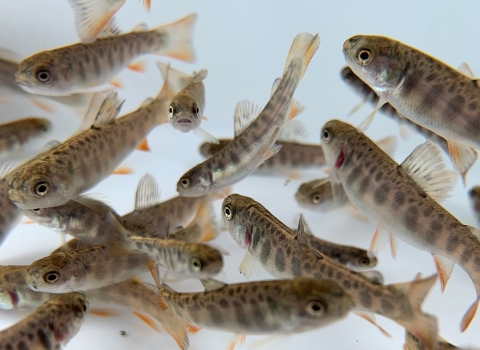What We Do
The Fish Technology Center was established to improve and enhance management effectiveness by providing consolidated technical operational support to regional fisheries operations, fish culture technical development, and the Service’s technical assistance to the emerging private aquaculture industry. The Fish Technology Center is comprised of the Cryopreservation Laboratory and the National Fish Strain Registry in Warm Springs, Georgia, and the Southeast Conservation Genetics Laboratory located at Auburn University.
Management and Conservation
Conservation Genetics
The Southeast Conservation Genetics Lab primarily works with federal and state biologists and managers in the southeast and the research community to design and implement genetics research on imperiled aquatic organisms. Current projects include estimating genetic diversity of Gulf Coast Striped Bass, Sicklefin Redhorse, numerous freshwater mussels, and threatened and endangered species such as the Spotfin Chub and the round rocksnail. In 2018, the Southeast Conservation Genetics Laboratory was moved to Auburn University to take advantage of the university setting.
Cryopreservation
Cryopreservation is a process in which a living cell is carefully frozen, stored, and thawed and remains viable. Cryopreserved sperm can conserve genetic diversity and assist in reproductive efforts by allowing spawning to take place whenever females are ready, reduces the need to hold males, and can increase flexibility and genetic diversity in spawning protocols. Currently, the WSFTC is working on numerous threatened or endangered fish species, and is expanding its cryopreservation research to include other aquatic species, such as freshwater mussels and amphibians, for conservation efforts.
National Fish Strain Registry
The National Fish Strain Registry (NFSR) is a broad collaborative program that provides access to data and information on our nation’s aquatic resources. The database houses information on life history, genetics, reproduction, and behavior of wild populations and domestic fish strains throughout the United States. The NFSR database is available for use by public and private producers as well as resource managers of federal, state, and tribal governments through a registration process.
Our Projects and Research
We use science and innovative technology to drive our management and conservation of aquatic resources. We work collaboratively with partners to effectively meet today’s complex conservation challenges
Conservation Genetics
Research in the lab addresses conservation issues pertaining to brood stock management, systematics of imperiled aquatic organisms, and population genetics for species of concern or management interest in the southeast. We also study the evolution of aquatic animals using genomic tools. The lab provides technical coordination for numerous southeastern aquatic species, focusing on fishes and mollusks.
Broodstock Evaluation and Monitoring Programs
Genetic Monitoring of Lake Sturgeon in the Tennessee River
The Tennessee River Lake Sturgeon Reintroduction Working Group was created in 1998 to start a reintroduction program for Lake Sturgeon in Tennessee. The group includes state, federal, and university scientists working towards the goal of establishing a naturally reproducing population of Lake Sturgeon in the Tennessee River. To ensure long-term success, the group developed a management plan that addresses genetic guidelines for stocking and genetic monitoring. Our Lake Sturgeon genetics work focuses on evaluating program success by examining genetic diversity of broodstock broodstock
The reproductively mature adults in a population that breed (or spawn) and produce more individuals (offspring or progeny).
Learn more about broodstock and captively reared individuals being reintroduced into the Tennessee River system. Data generated allows us to provide expertise and guidance to the working group.
Phylogenetics, taxonomy, and population genetics
Recent advances in genetic sequencing technologies allow us to generate massive genomic datasets in a small amount of time. We use genome-scale datasets to understand species relationships, gene flow among populations, and taxonomic boundaries. These data inform management decisions and result in better conservation outcomes.
Freshwater snail phylogenomics
Freshwater snails are important components of nearly all freshwater ecosystems in the eastern United States. Unfortunately, many are at-risk or listed as threatened or endangered under the Endangered Species Act. We use phylogenomic approaches, mostly anchored hybrid enrichment, to understand freshwater snail evolution. This allows us to place research and conservation efforts in an evolutionary context. Much of the lab’s work focuses on snails in the family Pleuroceridae, an ecologically important group that suffers from a 79% imperilment rate.
Development of Genetic Management Plans
Conservation planning is a collaborative endeavor with multiple stakeholders – government agencies, landowners, businesses, and scientists must all work together to protect natural resources. Genetic diversity and gene flow (transfer of genetic variation between populations) both support the health and long term sustainability of species in the wild. Genetic management plans (GMPs) are one tool that our lab uses to help describe the genetic status of declining species and provide guidance on how to best direct recovery efforts from a genetic perspective. Often, species facing extinction in the foreseeable future require intervention beyond monitoring and assessment. Managers sometimes make captive propagation, and ultimately reintroduction, a priority to increase the number of individuals and populations. GMPs are a written summary of genetic research findings such as estimated population size, potential barriers to gene flow, levels of inbreeding, ideal locations to choose when sourcing broodstock for captive propagation, and candidate areas for reintroduction. GMPs also provide broad guidance for recovery efforts.
Spectaclecase Genetic Management Plan
A unique species representing an ancient family of mussels, the Margaritiferidae, the spectaclecase (Cumberlandia monodonta) is found in patches throughout the eastern and midwestern United States. This species has a distinct elongated shell shape and can grow to become quite large, about 9 inches long. They inhabit rivers and can often be found under and around large rock slabs and boulders. Efforts to stop the decline of the Spectaclecase include preventing the spread of the invasive zebra mussel and captive propagation. We are interested in understanding the degree of genetic isolation between populations occurring across this relatively broad distribution and in identifying good sources for broodstock.
Cryopreservation Lab
The Cryopreservation Lab focuses on developing and implementing cryopreservation techniques to secure the remaining genetic diversity of endangered species, reduce issues caused by non-coincident mating, improve control in artificial spawning programs, and transfer wild genetics into hatchery stocks.
Cryopreservation: A Recovery Tool
The Cryopreservation Lab has collaborated with Mora National Fish Hatchery since 2015 to cryopreserve sperm from the rarest lineages of Gila Trout. Gila Trout are found in 14 populations in headwater stream habitats. Prior to 2006, Gila Trout were federally endangered. In 2006, it was downlisted to threatened after much work by several agencies including the USFWS, Forest Service, and game and fish departments in New Mexico and Arizona. Recovery efforts have included stream restoration, removing introduced trout, and restocking streams with young Gila Trout. We assist the Mora National Fish Hatchery by conducting freezing experiments, fertilization trials, and freezing of the five rarest lineages. Sperm from males of rare lineages are cryopreserved and added to the repository, which currently holds 514 males from five lineages from 2015-2020.
Aquatic Species Restoration
Sixty-two percent of all US fish species, 91 percent of all US mussels and more than two thirds of all North American species and sub-species of crayfish are found in the southeast United States. The Fish Tech Center conducts research on crayfish and amphibians to develop and improve on culture programs.
Amphibian Species Research
Invertebrate species sex is determined by either chromosomal factors (genetic sex determination, GSD) or environmental factors (environmental sex determination, ESD), or some combination thereof. In some species of reptiles, on the other hand, the sex ratio is determined by an environmental factor, in particular, by incubation temperature of the egg. In amphibians, the sex of larvae reared at ambient temperature is generally determined by GSD. The Fish Tech Center has been studying the influence of larval rearing temperature on sex of axolotl salamanders.
The National Fish Strain Registry database is a broad collaborative program that provides access to data and information on our nation’s aquatic resources. The database houses information on life history, genetics, reproduction, and behavior of wild populations and domestic fish strains throughout the United States. The database is available for use by public and private producers as well as...
Cryopreservation is a process in which a living cell can be frozen, stored, thawed, and remain viable for future growth. The cryopreservation lab at Warm Springs Fish Technology Center focuses...





